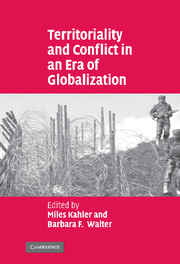Book contents
- Frontmatter
- Contents
- List of figures
- List of tables
- List of contributors
- Acknowledgments
- 1 Territoriality and conflict in an era of globalization
- Part I Territorial attachment and detachment
- Part II Territorial stakes and violent conflict
- Part III Territorial regimes in an era of globalization
- Conclusion
- References
- Index
- References
References
Published online by Cambridge University Press: 22 September 2009
- Frontmatter
- Contents
- List of figures
- List of tables
- List of contributors
- Acknowledgments
- 1 Territoriality and conflict in an era of globalization
- Part I Territorial attachment and detachment
- Part II Territorial stakes and violent conflict
- Part III Territorial regimes in an era of globalization
- Conclusion
- References
- Index
- References
- Type
- Chapter
- Information
- Territoriality and Conflict in an Era of Globalization , pp. 297 - 333Publisher: Cambridge University PressPrint publication year: 2006



